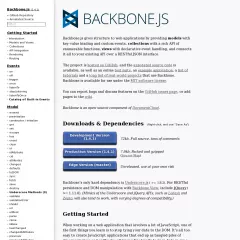Backbone.js 
Backbone.js is used by 0.24% of sites
Official Website
http://backbonejs.orgCategory
JavaScript Frameworks
Backbone.js is a lightweight JavaScript framework that provides structure and organization to web applications. It is often referred to as a "JavaScript library" or a "client-side framework." Backbone.js follows the Model-View-Controller (MVC) architectural pattern and offers a set of key components and utilities to build single-page applications (SPAs) and enhance the structure of JavaScript code.
Here are some key aspects and features of Backbone.js:
Models: Models in Backbone.js represent the data and business logic of an application. They encapsulate data attributes, define validation rules, and provide methods for manipulating and interacting with the data. Models can also communicate with the server-side backend through RESTful APIs.
Views: Views handle the presentation logic of an application. They define the structure, layout, and rendering of the user interface. Views can listen to changes in models and update the UI accordingly. They can also capture user input and trigger actions within the application.
Collections: Collections are ordered sets of models. They represent a group of related models and provide methods for querying, filtering, and manipulating the models as a group. Collections can also fetch data from the server-side API and keep the models synchronized with the backend.
Events and Event Handling: Backbone.js provides an event-driven architecture, allowing objects to bind and trigger custom events. Models, views, and collections can listen to specific events and respond accordingly. This mechanism facilitates communication and coordination between different components of the application.
Routing: Backbone.js includes a built-in router that enables the creation of bookmarkable URLs and manages the navigation within a single-page application. The router maps URLs to specific actions, allowing users to navigate through different views or sections of the application.
Data Binding: Although Backbone.js does not provide two-way data binding out of the box, it allows developers to establish manual bindings between models and views. Developers can listen for changes in models and update the corresponding views or vice versa.
Syncing with the Server: Backbone.js provides support for syncing data between the client-side and server-side. It integrates with RESTful APIs and provides methods for saving, fetching, and deleting models from the server. Developers can customize the syncing behavior based on their specific server-side implementation.
Extensibility: Backbone.js is intentionally lightweight and offers a flexible and minimalistic structure. It allows developers to extend and customize its components to fit the requirements of their applications. Additional functionality can be added through plugins and extensions.
Backbone.js is suitable for developers who prefer a lightweight framework and want to structure their JavaScript code using the MVC pattern. It provides a solid foundation for building single-page applications, simplifies data management, and promotes separation of concerns within the codebase.
Here are some key aspects and features of Backbone.js:
Models: Models in Backbone.js represent the data and business logic of an application. They encapsulate data attributes, define validation rules, and provide methods for manipulating and interacting with the data. Models can also communicate with the server-side backend through RESTful APIs.
Views: Views handle the presentation logic of an application. They define the structure, layout, and rendering of the user interface. Views can listen to changes in models and update the UI accordingly. They can also capture user input and trigger actions within the application.
Collections: Collections are ordered sets of models. They represent a group of related models and provide methods for querying, filtering, and manipulating the models as a group. Collections can also fetch data from the server-side API and keep the models synchronized with the backend.
Events and Event Handling: Backbone.js provides an event-driven architecture, allowing objects to bind and trigger custom events. Models, views, and collections can listen to specific events and respond accordingly. This mechanism facilitates communication and coordination between different components of the application.
Routing: Backbone.js includes a built-in router that enables the creation of bookmarkable URLs and manages the navigation within a single-page application. The router maps URLs to specific actions, allowing users to navigate through different views or sections of the application.
Data Binding: Although Backbone.js does not provide two-way data binding out of the box, it allows developers to establish manual bindings between models and views. Developers can listen for changes in models and update the corresponding views or vice versa.
Syncing with the Server: Backbone.js provides support for syncing data between the client-side and server-side. It integrates with RESTful APIs and provides methods for saving, fetching, and deleting models from the server. Developers can customize the syncing behavior based on their specific server-side implementation.
Extensibility: Backbone.js is intentionally lightweight and offers a flexible and minimalistic structure. It allows developers to extend and customize its components to fit the requirements of their applications. Additional functionality can be added through plugins and extensions.
Backbone.js is suitable for developers who prefer a lightweight framework and want to structure their JavaScript code using the MVC pattern. It provides a solid foundation for building single-page applications, simplifies data management, and promotes separation of concerns within the codebase.